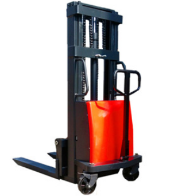News Details
The method of lifting and hoisting with hydraulic stacker crane and rigging equipment
Hydraulic forklift is a type of forklift with special functions. It can not only perform handling work, but more importantly, it can also stack goods. The height of some hydraulic forklift forks can even reach about four meters, which solves the problem of placing goods on warehouse shelves.
Like most forklifts, hydraulic stackers are mainly used in conjunction with pallets, but there are also special cases where hydraulic stackers are used as lifting cranes. The hydraulic stacker is capable of lifting and hoisting, and when it demonstrates this ability, the partner switches from a pallet to a sling.

The lifting and hoisting work of hydraulic stacker crane is generally carried out by first connecting and fixing the lifting target with lifting slings, and then connecting the lifting slings to the forks. This process must ensure that the lifting slings are perpendicular to the center of gravity of the lifting target. After all the work is ready, the lifting and hoisting work is achieved by lifting the forks of the hydraulic stacker crane.
This is the use of hydraulic stacker crane combined with hoisting equipment, which belongs to the operation of the side door. During the use, it is necessary to ensure the verticality of the hoisting equipment, avoid shaking after lifting, and more importantly, ensure that the weight of the lifting target is within the rated load range of the hydraulic stacker crane.

